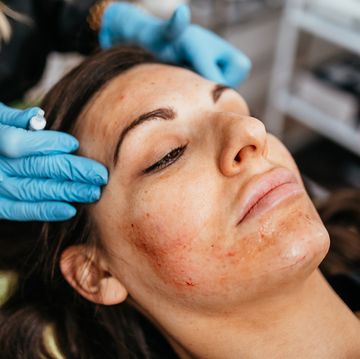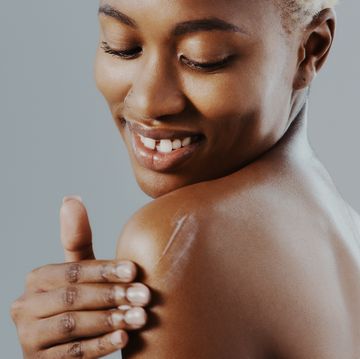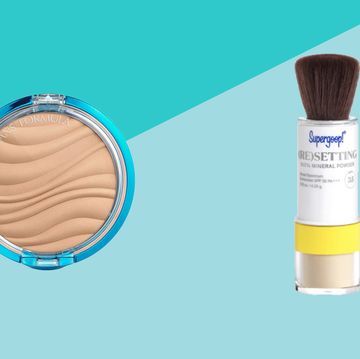It's a cruel reality that once you're at the age where the little things no longer irk you, your skin takes the opposite turn, turning red, irritated, and flaky at the slightest thing. It's suddenly, well, sensitive! And if you feel like you're constantly trying to soothe skin issues, you're not alone: "I notice that more women are coming into my office and saying they have sensitive skin," says Francesca Fusco, MD, an assistant clinical professor of dermatology at Mount Sinai School of Medicine. Indeed, over 50% of women categorize themselves that way.
The reason? Our quest for younger-looking skin may be to blame, says New York City dermatologist Ellen Marmur, MD: "Women are very committed to caring for their skin, but they're often diagnosing themselves with new issues and use so many new products to solve them that they develop irritation," she says. Cleansing religiously, exfoliating too often, and topping it all off with a generous layering of anti-aging products are just a few of the things that send our complexions into a tailspin. Increasing stress and environmental allergies also make skin more prone to problems. (Want the truth behind your favorite anti-aging ingredients? We debunked eight.)
Despite countless rows of products labeled "for sensitive skin" on store shelves, treating an unruly complexion isn't a one-size-fits-all affair. "Sensitive" products that work well for your friend's skin could just as easily wreak havoc on yours, so it's important to get beyond the general label and figure out what's really bugging your skin. Here, six common symptoms, and the right ways to treat them:
Your Sensitive Symptoms: Taut and itchy skin
It might mean: Your cleanser is too drying. "It's the number one culprit behind unnecessary irritation," says skin care expert and celebrity esthetician Renée Rouleau. Avoid sodium lauryl sulfate and ammonium laureth sulfate, harsh detergents commonly used in facial cleansers and soaps that break down the natural lipids in skin. When this happens, it's like a double whammy. "Little invisible cracks in the skin form, causing moisture to seep out and allowing irritants in. Suddenly, other products in your routine that didn't irritate your skin before might now," she says.
The fix: "Don't wash your face with soap more than once a day," says New Orleans-based dermatologist Mary Lupo, MD. "In the morning, wash with a face moisturizer instead of a cleanser or simply splash water on skin to maintain moisture. Then apply a moisturizer with an SPF." Try CeraVe Facial Moisturizing Lotion AM with SPF 30 ($13; drugstores) or Vichy Capital Soleil Daily Moisturizer Cream with SPF 15 ($32; vichyusa.com). Then, wash your face at night with a sulfate-free cleanser, like Renée Rouleau Gentle Gel Cleanser ($35.50; reneerouleau.com) or The Body Shop Aloe Calming Facial Cleanser ($14.50; thebodyshop-usa.com).
Find natural remedies for acne, allergies, and more! Order your copy of The New Healing Herbs. [pagebreak]
Your Sensitive Symptoms: Burning and stinging
It might mean: Anti-aging product overload. Packing too many anti-aging ingredients into your routine can make skin misbehave. First, it's a simple matter of probability, explains Macrene Alexiades-Armenakas, MD, PhD, assistant clinical professor of dermatology at Yale School of Medicine: "The more products you use, the greater chance one won't agree with your skin." Second, mixing different anti-aging ingredients, like retinoids and alpha hydroxy acids—both of which work by sloughing off dead, dull cells to reveal healthier and more youthful skin underneath—means that you're essentially exfoliating twice, which can seriously strip skin and increase the potential for irritation, she says. (Prevent a skin disaster with Your Guide to Retinols and Retinoids!)
The fix: Stick to one moisturizer or serum fortified with anti-agers. Those that include ingredients that build up skin's barrier, like peptides or niacin, will help reduce risk of irritation, notes Dr. Marmur. Two gentle choices: StriVectin-SD for Sensitive Skin ($72, strivectin.com), packed with peptides to boost collagen, nitrogenic acid (a form of niacin), and soothing rose and cucumber extracts, or Atopalm Moisturizing Skin Revitalizing Complex ($35; atopalmusa.com) with peptides, vitamin C, and licorice to plump up fine lines and boost brightness.
Your Sensitive Symptoms: Blushing and flushing, sometimes accompanied by tiny red pimples
It might mean: You have rosacea. Characterized by blood vessels that swell and produce redness at the slightest agitation—from cold, heat, wind, stress, or spicy foods—the condition traditionally develops after age 30. The exact cause is still unknown, and specific triggers differ for everyone. What experts do know: A liberal, daily application of an SPF 30 is a must. Sun exposure breaks down the supportive structures, like collagen, around blood vessels, exacerbating redness, explains Miami dermatologist Leslie Baumann, MD, author of The Skin Type Solution.
The fix: Temper sensitivity with anti-inflammatory soothers, like feverfew, in First Aid Beauty Daily Face Cream ($20, firstaidbeauty.com) or green tea and caffeine in Topix Replenix Serum CF ($67; skinstore.com). Apply sunscreen daily to prevent symptoms from getting worse. Sensitive skin often can't tolerate chemical UV filters, like avobenzone, but physical blockers titanium dioxide and zinc oxide protect without irritation. Try Aubrey Organics Natural Sun SPF 30+ Unscented Sensitive Skin ($15.95; Aubrey-organics.com), Dermalogica Super Sensitive Shield SPF 30 ($48; dermalogica.com), and MDSolarSciences Mineral Créme SPF 50 Broad Spectrum UVA-UVB ($30; mdsolarsciences.com). For serious, persistent rosacea, see your dermatologist, who can recommend the right treatment for your skin.
Your Sensitive Symptoms: Scaly, rough patches on the skin
It might mean: You're having an eczema flare-up. When working properly, the top layer of skin acts like a strong film of plastic wrap that seals in hydration and protects deeper layers of skin. Eczema-prone complexions suffer from a faulty barrier that allows water to easily escape, leading to extreme dryness and flakiness. "When irritants like smoke and fragrances then settle on skin, immune cells rush to the area to respond, triggering inflammation," notes Amy Taub, MD, an assistant clinical professor of dermatology at Northwestern University. Though 90% of people are diagnosed before age 5 and symptoms often fade during childhood, eczema is a chronic condition that may make you more prone to dryness and irritation at any age.
Having dry skin doesn't mean you have eczema, though dryness can also make skin more sensitive. Follow the dry skin cleansing advice above and the moisturizing advice below to help boost hydration.
The fix: To enhance skin's resilience, apply a humectant-based moisturizer after cleansing while skin is still moist. Try Avène Trixéra + Sélectiose Emollient Cream ($29; aveneusa.com for info on where to buy), Curel Itch Defense Lotion for Dry Itchy Skin ($7.99; drugstores), and Jergens Fragrance Free Sensitive Skin Daily Moisturizer ($6; drugstores)[pagebreak]
Your Sensitive Symptoms: Eye-area redness, puffiness, and wrinkles that look like they've appeared overnight
It might mean: Your eye area is especially thin and delicate, making it more sensitive. But you may mistakenly blame your eye cream for irritation in this area when nail polish is often the real culprit, says Dr. Fusco. Why? "Many people are allergic to the formaldehyde and toluene in polish—and touching or rubbing your eyes several times a day can trigger a reaction," she says. Fragrances in scented hand lotions and other products can cause similar sensitivities.
The fix: Apply fragrance-free hand creams. In terms of polish, brands like CND (cnd.com) and Orly (orlybeauty.com) no longer contain those chemicals, but they're still present in many polishes, so read the label or check the Web site of your favorite shade before applying.
Your Sensitive Symptoms: Small red bumps (not pimples) on your face that may itch
It might mean: You're allergic to one of your products. During an allergy attack, immune cells in your skin react, causing a cascade of symptoms: first, red bumps, then dryness and flakiness, and finally, a leathery texture, explains Dr. Fusco. Frequent offenders, she says, include topical ingredients like alcohol, fragrance, artificial dyes, and preservatives like parabens. Quell a reaction by applying a .05% over-the-counter hydrocortisone cream for up to 5 days. If inflammation persists, head to the derm.
Allergy symptoms may appear a few hours after using the offending product—or up to 2 weeks later. It's important to introduce new products slowly and not all at once, so you can better pinpoint any problems. For people with especially sensitive complexions, try products using a patch test, suggests Rouleau: At night, apply the product to the side of your face in a 2-inch-by-2-inch area, following up with your normal routine. If there's no sign of inflammation (such as a rash or swelling) in the morning, use over your entire face the next night.
The fix: Of course, you can't eliminate risk of irritation all together, but you can at least decrease it by using products formulated without fragrances, preservatives, and other known allergens. We like VMV Hypoallergenics (vmvhypoallergenics.com) and Derma E's fragrance-free products (dermae.net).
More from Prevention: Learn The New Sunscreen Label Lingo













